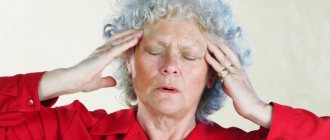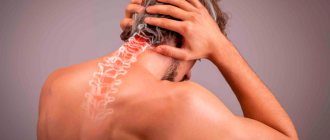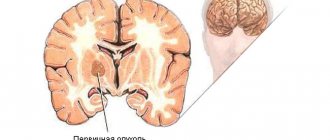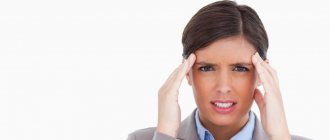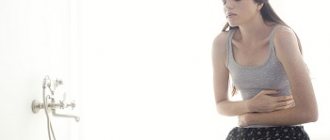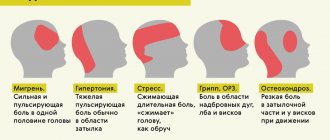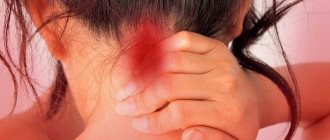Pulsation in the head is a fairly common phenomenon that can take any person by surprise; this condition occurs for many reasons, but it must be taken into account that this symptom may indicate the development of serious diseases in the body, or may be caused by banal overwork.
The sensation of pulsation in the head may be accompanied by pain, or it may pass almost without pain.
If there is a throbbing pain in the head, then its localization, shape and nature of the pain syndrome helps to correctly identify the provoking factor. Treatment should be prescribed by a specialist after a preliminary examination and determination of the cause of discomfort in the head.
In most cases, pulsation in the head, which is almost painless, occurs as a result of stressful situations and fatigue. In such a situation, it has no consequences and occurs quite rarely. To get rid of discomfort, you should take a sedative.
As already indicated, pulsation in the head can be accompanied by pain or occur without it; this symptom occurs in patients of different age groups and as a result of various provoking factors; the patient may also experience tinnitus in parallel.
Thus, the vessels of the brain manifest themselves, in which impaired blood flow is observed. Throbbing pain can be localized in the back of the head, temples, and also in the parietal or frontal areas.
At the first manifestations of painful pulsation, you should immediately contact a specialist for qualified help.
Causes of throbbing pain in the back of the head
The feeling that the back of the head is throbbing from a headache indicates damage to the nerves or blood vessels, their inflammation or mechanical compression. Based on the intensity and nature of the painful sensations, we can tentatively assume their cause:
- acute, throbbing pain in the back of the head, which spreads to the entire surface of the head - infectious diseases, including influenza, meningitis, encephalitis;
- sharp pain in the form of repeated attacks is a manifestation of cervical migraine;
- unilateral or symmetrical pain in the back of the head, which causes numbness in the hands - damage to the occipital nerve;
- dull, aching pain – ischemia, insufficient blood supply to the occipital region.
If throbbing pain in the back of the head is accompanied by numbness in the hands, impaired hearing, vision or speech, or coordination of movements, it is important to exclude the possibility of a stroke. You should consult a doctor within the first 2 hours after an attack - it is during this period that medical care is most effective.
Vascular diseases
Pulsation in the back of the head is one of the manifestations of acute and chronic diseases of the vascular system. Important arteries that carry blood to the brain may be compressed from the outside or blocked from the inside. These processes, as well as infectious diseases, are accompanied by inflammation, pain, and insufficient blood supply to certain areas. These include:
- atherosclerosis is a chronic metabolic pathology in which the products of fat metabolism are deposited on the inner wall of the arteries and cholesterol plaques are formed;
- vasculitis - inflammation of blood vessels caused by injuries, compression of arteries or veins, as well as infectious processes;
- Vascular dystonia is a complex disorder that is accompanied by frequent surges in pressure and insufficient blood supply to the head and lower extremities.
For various vascular diseases, it is important to restore normal blood flow in the head, neck and back of the head. For this, medications, exercises, and physiotherapy sessions are prescribed. If acute or chronic vascular diseases are suspected, an ultrasound examination with a contrast agent is performed.
Diseases of the cervical spine
Throbbing pain in the back of the head can be a sign of acute or chronic neck diseases. They cause compression or spasm of the vertebral artery, which is important for cerebral circulation. As a result, the patient experiences acute, throbbing pain in the back of the head, dizziness, nausea, hearing and vision impairment. Symptoms disappear after a course of treatment, which eliminates the underlying cause of the pain.
As a result of diagnostics, the following violations may be detected:
- osteochondrosis is a chronic disease of the joints of the spine, which leads to thinning of the cartilage discs and deformation of the vertebrae;
- displacements and subluxations of the vertebrae - a violation of the anatomically correct placement of segments of the spinal column, which causes compression of the vessels and roots of the spinal nerves;
- protrusion of intervertebral discs - protrusion of cartilage in any direction, which is accompanied by acute pain in the neck and back of the head, as well as limited mobility;
- spondylosis is the fusion of two or more adjacent vertebrae as a result of trauma, surgery, or chronic deforming processes.
Cervical migraine is a disease that often progresses. It can worsen when weather or climate conditions change, or due to stress or physical exertion. The condition can be normalized with painkillers and antispasmodics, and the doctor can also prescribe muscle relaxants.
High blood pressure
Hypertension is considered a disease of older people, but in reality it can occur at any age. Increased stress, weakness of the vascular walls, excess weight and poor diet, as well as cardiac dysfunction are the main causes of this disease. Hypertension is considered to be an increase in blood pressure to levels greater than 120∕80 mm. rt. Art.
High blood pressure can be identified by the following symptoms:
- throbbing pain in the head, in the occipital region;
- dizziness, with a sharp increase in pressure, fainting is possible;
- redness of the facial skin, burning sensation, tingling, numbness;
- deterioration of hearing and vision, the appearance of dark circles before the eyes.
Doctors at the Clinical Institute of the Brain recommend having a tonometer in your home medicine cabinet, even if you have not previously experienced problems with high or low blood pressure. It is important to know your own normal indicators in order to notice the onset of an attack in time. They should be measured at rest - after physical activity and stress, pressure normally increases.
Neuralgia
Throbbing pain in the back of the head is one of the first signs of occipital neuralgia. It originates from the second cervical vertebra, passes through the muscles of the neck, under the base of the skull and goes to the scalp. Neuralgia refers to painful sensations that occur due to inflammation or mechanical compression of a nerve. The pain is acute, throbbing, lasts from several hours to several days, disappears after taking analgesics. Its causes may be:
- cervical spine injuries are the most common cause;
- degenerative diseases of the first two cervical vertebrae;
- arthritis – inflammatory diseases of the joints;
- neoplasms that compress the nerve.
Occipital neuralgia can occur in the absence of any congenital anomalies or chronic diseases. Its development is facilitated by incorrect posture, prolonged sitting, stress and other factors. One common cause is a spasm of the neck muscles, in which the nerve is compressed as it passes through this area.
Other reasons
If pain in the back of the head throbs frequently, this should be a reason for a full examination. During diagnosis, various disorders may be detected that require timely treatment:
- neoplasms located in the back of the head;
- diseases of the muscles of the back of the neck;
- increased intracranial pressure;
- migraine.
Headache is not the only symptom that indicates diseases of the heart and blood vessels, nervous system, neck and spine. It may be accompanied by nausea, deterioration of memory and attention, numbness of the hands and fingers, and sleep disorders.
What to do when there is a knocking in the ear - how to treat it?
It is not possible to treat pounding in the ear separately, since it is not an independent disease, but only a clinical symptom. If you experience a knocking sound in your ear, you should seek medical help as soon as possible.
The first thing to do if there is a knock in the knot is to make an appointment with a vertebrologist. This doctor is well versed in pathologies of the spinal column. He will conduct an examination, make an accurate diagnosis, and give all the necessary recommendations for rehabilitation treatment.
At our chiropractic clinic, we treat musculoskeletal conditions, many of which can cause pounding in the ear. For example, to treat cervical osteochondrosis complicated by posterior vertebral artery syndrome, we use the following techniques:
- manual traction of the spinal column - allows you to increase the intervertebral spaces, which creates favorable conditions for the complete straightening of the discs and eliminating pressure on the surrounding soft tissues;
- osteopathy to restore microcirculation processes of blood and lymphatic fluid, which has a beneficial effect on the condition of all tissues;
- massage to relax overly tense muscles of the neck and collar area;
- kinesiotherapy and therapeutic exercises to restore normal muscle fiber tone and start the disrupted process of diffuse nutrition of cartilage discs;
- physiotherapy, laser, reflexology and much more.
You can right now make an initial free appointment with a vertebrologist or neurologist at our manual therapy clinic in Moscow. To do this, fill out the registration form located further on the page.
Diagnostic methods
To prescribe an effective treatment regimen, it is important to understand the cause of throbbing pain in the back of the head. Doctors at the Clinical Institute of the Brain recommend signing up for an examination if the attacks are repeated frequently and are of high intensity. To confirm the diagnosis, consultations with a therapist, neurologist, traumatologist, surgeon, as well as additional examinations may be required:
- MRI of the head and neck to exclude any damage, neoplasms, or diseases of the spine;
- magnetic resonance angiography is a method of examining the vessels of the head and neck in order to identify their inflammation, blockage, and also detect areas of ischemia;
- Dopplerography – ultrasound diagnostics of blood vessels using a contrast agent;
- ophthalmological examinations - checking the fundus, determining visual acuity, measuring intraocular pressure;
- blood tests to identify inflammatory processes and dysfunction of individual organs.
The Clinical Institute of the Brain has all the conditions for a full diagnosis of headaches in the back of the head. Our advantages are high-quality, modern equipment and specialists who regularly improve their skills.
Why does this feeling happen?
In a healthy person, when exposed to certain factors, tinnitus and pulsation may suddenly occur. The head may feel light or, conversely, feel unusually heavy. This most often happens with sudden fear, stress or severe physical strain. This condition causes the heart rate to increase and the arteries to narrow at the same time. Therefore, blood, pushing under pressure through the vessels, causes them to pulsate.
Such headaches can occur as a reaction to changing weather conditions, hormonal fluctuations in women, due to a sedentary lifestyle, or due to weakened immunity after serious illnesses. Hypothermia or even excessive consumption of cold foods can also cause throbbing in the head. Often this feeling occurs as a result of severe overwork, accumulated fatigue or emotional overstrain.
Treatment of headaches in the back of the head
The treatment regimen is selected individually, based on the results of the examination. Some medications are prescribed to relieve headache attacks, while others should be taken regularly. You may also need additional techniques that will help improve blood supply to the brain and normalize blood counts. The treatment regimen may include the following stages:
- drug therapy: painkillers and antispasmodics, drugs for the treatment of migraines, to stabilize lipid metabolism (for atherosclerosis), increase or decrease blood pressure;
- physiotherapy - a set of techniques aimed at accelerating tissue regeneration processes and improving blood circulation, indicated for diseases of the cervical spine;
- physical therapy – simple exercises to strengthen and increase the elasticity of muscles and ligaments are important to perform regularly;
- surgical intervention is necessary only in case of detection of tumors, aneurysms and other neoplasms, as well as for the treatment of certain deforming diseases of the spine.
The Clinical Brain Institute specializes in the treatment of headaches caused by various disorders. Doctors will help you choose the optimal regimen of medications and procedures that will help get rid of not only the symptoms, but also the causes of discomfort. In most cases, treatment is carried out at home, but the patient must strictly follow all instructions.
Prevention of headaches
Doctors have several recommendations on how to avoid headaches in the back of the head. To do this, you should fulfill a number of conditions at home:
- healthy eating, avoidance of large amounts of animal fats;
- correct posture, including during work;
- good sleep, spending time in the fresh air;
- control over pressure level.
If you have throbbing pain in the back of your head, you should contact specialists at the Clinical Brain Institute for diagnosis and treatment. High-quality modern equipment, highly qualified doctors, and the possibility of inpatient examination are the main advantages of the center.
Clinical Brain Institute Rating: 4/5 — 7 votes
Share article on social networks
Vegetative-vascular dystonia: symptoms in adults
Treatment of this disease consists only of relieving unpleasant sensations, since in many countries it is not even considered a disease, referring to the manifestation of other pathologies. This condition is also called neurocirculatory dysfunction. Quite often, when teenage girls complain of shortness of breath, weakness, dizziness, decreased performance and throbbing pain, doctors diagnose “vegetative-vascular dystonia.” Symptoms in adults, treatment and prevention of attacks of this disease usually do not change with age. But the disease occurs mainly in women under 30 years of age. The problems that arise in this case are associated with impaired vascular tone. This is what causes the sensation of pulsation in the back of the head or temples.
